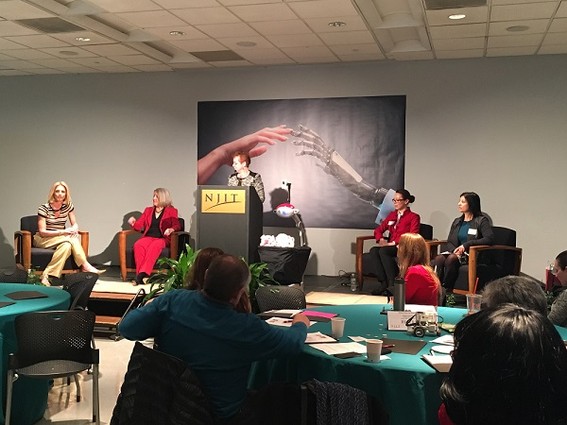Murray Center Conference Features Women Involved in Drone, Robot and AI Work

The 2017 Women Designing the Future Conference, held on March 24 and hosted by the Murray Center for Women in Technology at NJIT featured women who are pioneering the emerging world of robotics and artificial intelligence.
Included were women who own robotics companies, like Wendy Roberts, founder and CEO of Five Elements Robotics (Wall), whose company produces commercially available home robots; and women who are developing the future of robotics, like the NJIT students and a researcher at the Kessler Institute for Rehabilitation (West Orange), who talked about the robotic exoskeletons they were developing. These robots were being used to rehabilitate stroke or accident victims and to help disabled people function better.
The keynote speaker for the event was Julia Kirby, senior editor at Harvard University Press (Cambridge, Mass.) and coauthor of the book “Only Humans Need Apply: Winners and Losers in the Age of Smart Machines.” Kirby’s talk centered on how and when robots will take away masses of human jobs, and what we need to do to create a trained workforce that can help AI devices and robots do their work.
Bad Bot, Good Bot
A panel discussion called “Bad Bot, Good Bot,” moderated by Judith Sheft, associate vice president of technology and enterprise development at NJIT’s New Jersey Innovation Institute, delved into the issues surrounding bot adoption, including privacy and regulatory issues.
The panelists included Alice DiSanto, director of marketing at Sharp Robotics Business Development Group (Montvale), who is also involved in Robolliance (Montvale), an organization composed of thought leaders within the robotics and security ecosystem; Linda Ziemba, founder and president of Drone Go Home (Highlands); Ksenia Vereshchaga, cofounder and COO of TeleRetail (Germany and Sunnyvale, Calif.); and Cynthia Hetherington, president of the Hetherington Group (Wanaque).
Sharp Robotics Business Development has a robot in the security and surveillance space called the “INTELLOS Automated Unmanned Ground Vehicle.” Drone Go Home, founded in October 2015, is a drone detection, location and alerting service. “We are not against drones. They are going to do some really great, cool things. But they shouldn’t be everywhere all the time and have free reign,” Ziemba said.
Vereshchaga’s company makes “Urban Courier Robots,” which offer automated local deliveries to meet the steadily growing demand for cost-efficient last-mile transportation of goods in a smart city ecosystem.
Hetherington Group is a high-end private detective agency that advises companies on security and that’s also part of Robolliance. The company specializes in cybersecurity and cyber counterterrorism. “We are applying [robots, drones and AI] to real-world applications to keep people safe, to protect bridges and borders and to keep our communities as open … as possible,” said Cynthia Hetherington, who’s an NJIT grad.
Regulatory Issues Discussed
Sheft asked about the legal and regulatory issues that could limit the ability of companies in this industry to enter markets. Ziemba had an interesting answer. Drone Go Home started out with the idea that it would ethically hack the signals from drones and prevent them from flying where they didn’t belong. In the case of prisons, drones could be dropping in cell phones, weapons or drugs, she said. “We were very confident we were on the right side.
“It turns out we were violating FAA regulations for impacting the flight of an aircraft because the FAA 2012 Modernization and Reform Act classified unmanned drones as having equal rights to a jumbo jet.” The startup was also violating regulations of the Federal Communications Commission (FCC) and the National Telecommunications and Information Administration (NTIA) because they were affecting radio communication signals. Also, “we were violating federal wiretapping laws” because Drone Go Home was reading the content of communication streams.
After doing due diligence and complying with the agencies involved, the startup pivoted to a technology that only detects drones, Ziemba said. “We don’t tap into the signal.” And now, “we are one of a handful of companies” that can be considered to have legal drone-detection ability.
DiSanto said that, for INTELLOS, “we had the benefit of seeing what was going on with the air drones.” The vehicle can operate in open areas and it can also operate safely around people. However, “we decided not to push that heavy stone uphill in the beginning, and dedicated our particular robot for outdoor spaces that are fenced in with low levels of population interaction.”
Sharp Robotics felt that it needed to prove the safety of the device with a limited number of people before moving on. “Also, by being inside a fenced-in area, we weren’t subjected to the things we are seeing with the Google car,” DiSanto explained. To be socially responsible, the company voluntarily submitted its design to several standards organizations.
Vereshchaga said that her company is navigating rules that differ from city to city. In some cities, she said, the startup is able to test its urban-delivery robot on sidewalks, but in other cities this isn’t allowed yet. On the other hand, she noted that many states and cities are trying to create ecosystems for startups, and they will end up attracting more companies like hers, which will demonstrate their capabilities and learn about pitfalls in their urban labs.
Asked about the need for qualified people to work in this field, Hetherington said that the tech students in the audience will be needed to interpret the new technology to the old guard, “who will be your managers” both at companies and in the government. “You will be the ones to introduce these new technologies. Your use, understanding and prolific adaptation of this technology is going to wake up somebody in management.”

